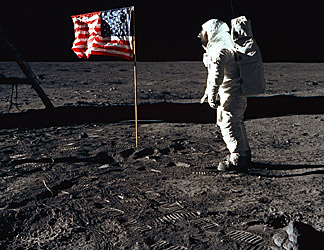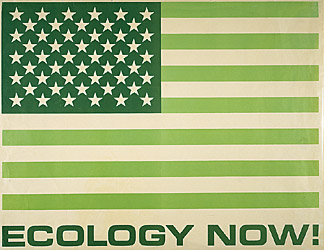The Flag in the Sixties
In July 1969, images of Apollo 11 astronauts planting the American flag on the Moon signaled a profound achievement for the nation and the world. Back on Earth, however, the Star-Spangled Banner was struggling to stay aloft in a strained and highly charged political atmosphere. During this decade of intense social divisions, the flag became a contested symbol of pride and protest in struggles over civil rights, foreign policy, and cultural values. Civil rights activists carried the American flag to pressure the nation to live up to its ideals of freedom and equality, while white segregationists flew Confederate flags to oppose the intervention of the federal government in their communities and to defend “the Southern way of life.†In the home front battle over Vietnam, both sides used the flag to express their views about the morality and necessity of the war, sometimes with violent results.
Perhaps no issue epitomized the controversial nature of the American flag during the 1960s more than flag burning. When some burned the flag to protest government policies, others rushed to defend the flag from attack. State laws against flag desecration originally passed in the late 1800s were revived and enforced. In 1968, Congress passed the Federal Flag Desecration Law, making it a federal crime to “knowingly cast contempt upon any flag of the United States by publicly mutilating, defacing, defiling, burning, or trampling upon it.â€
After peaking in the late 1960s, the issue of flag desecration receded from the public spotlight. It would be revived twenty years later by the 1989 U.S. Supreme Court ruling Texas v. Johnson, which struck down all state and federal flag protection laws as violating the First Amendment right to free speech. Since then, politicians have made repeated efforts to amend the Constitution to prohibit flag burning, a move opposed by those who believe it would curtail essential civil liberties. As the debates over flag protection continue, memories of the turbulent 1960s continue to challenge and inspire Americans to contemplate the meaning of patriotism and the value of protest.
Interact IntroductionCollect Stars To Complete The Flag
What did the court case Texas v. Johnson decide?
- The flag should be protected from harm or desecration
- The flag may be used in protest but not destroyed
- Federal and state flag-protection laws violate the right of free speech
-

Moon landing
Astronauts Buzz Aldrin and Neil Armstrong plant the American flag on the Moon July 20, 1969
-

Stars-and-stripes lunchbox
Manufactured in 1970 by Aladdin Industries, Inc., of Nashville, Tennessee, this steel lunch kit appealed both to counterculture teens and patriotic construction workers.
-

Ecology poster
Inspired by antiwar activists who replaced the field of stars with a peace sign, environmentalists also altered the flag to make a political statement and promote their new movement for a “greener†America.
-

Jeans with flag patch
During the 1960s, many young Americans embraced the flag as a symbol of personal freedom.



